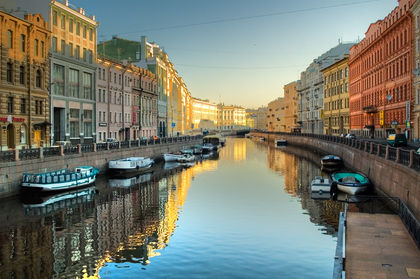RUSSIA

Russian Federation
Rossiyskaya Federatsiya
CAPITAL : Moscow
FLAG : Equal horizontal bands of white (top), blue, and red.
ANTHEM : Patriotic Song.
MONETARY UNIT : The rouble ( R ) is a paper currency of 100 kopecks. There are coins of 1, 2, 3, 5, 10, 15, 20, and 50 kopecks and 1 rouble, and notes of 100, 200, 500, 1,000, 5,000, 10,000 and 50,000 roubles. R 1 = $0.0322 (or $1 = R 31.10) as of May 2003.
WEIGHTS AND MEASURES : The metric system is the legal standard.
HOLIDAYS : New Year's Day, 1–2 January; Christmas, 7 January; Women's Day, 8 March; Spring and Labor Day, 1–2 May; Victory Day, 9 May; State Sovereignty Day, 12 June; Socialist Revolution Day, 7 November.
TIME : 3 PM Moscow = noon GMT.
TOPOGRAPHY
The topography of Russia features a broad plain with low hills west of the Ural Mountains with vast coniferous forests and tundra in Siberia. There are uplands and mountains along the southern border region. Despite its size, only a small percentage of Russia's land is arable, with much of it too far north for cultivation.
ETHNIC GROUPS
The most recent estimates indicate that 81.5% of the population is Russian. Tatars constitute 3.8%; Ukrainians make up 3%; Chuvash form 1.2%; Bashkir account for 0.9%; Belarussian for0.8%; Moldavian for 0.7%; and a wide variety of other peoples are represented in the remaining 8.1%.
DEPENDENCIES
The Russian Federation has no territories or dependencies.
BIBLIOGRAPHY
Aslund, Anders. How Russia Became a Market Economy. Washington, D.C.: Brookings Institution, 1995.
Blasi, Joseph R. Kremlin Capitalism: The Privatization of the Russian Economy. Ithaca, N.Y.: ILR Press, 1997.
Buckley, Mary. Redefining Russian Society and Polity. Boulder, Colo.: Westview Press, 1993.
Dallin, Alexander (ed.). Political Parties in Russia. Berkeley: International and Area Studies, University of California at Berkeley, 1993.
Durgo, A.S. (ed.). Russia Changes: The Events of August 1991 and the Russian Constitution. Commack, N.Y.: Nova Science, 1992.
Gooding, John. Rulers and Subjects: Government and People in Russia, 1801–1991. New York: St. Martin's Press, 1996.
International Smoking Statistics: A Collection of Historical Data from 30 Economically Developed Countries. New York: Oxford University Press, 2002.
Khasbulatov, R.I. The Struggle for Russia: Power and Change in the Democratic Revolution. New York: Routledge, 1993.
Mastyugina, Tatiana. An Ethnic History of Russia: Pre-Revolutionary Times to the Present. Westport, Conn.: Greenwood Press, 1996.
McFaul, Michael. The Troubled Birth of Russian Democracy: Parties, Personalities, and Programs. Stanford, Calif.: Hoover Institution Press, Stanford University, 1993.
The Modern Encyclopedia of Russian, Soviet and Eurasian History. Gulf Breeze, Fla.: Academic International Press, 1994.
Pushkareva, N. L. Women in Russian History: From the Tenth to the Twentieth Century. Armonk, N.Y.: M. E. Sharpe, 1997.
Raymond, Boris, and Paul Duffy. Historical Dictionary of Russia. Lanham, Md.: Scarecrow, 1998.
Steele, Jonathan. Eternal Russia: Yeltsin, Gorbachev and the Mirage of Democracy. Boston: Faber, 1994.
Summers, Randal W., and Allan M. Hoffman (ed.). Domestic Violence: A Global View. Westport, Conn.: Greenwood Press, 2002.
Thurston, Robert W. Life and Terror in Stalin's Russia, 1934–1941. New Haven: Yale University Press, 1996.
Tuller, David. Cracks in the Iron Closet: Travels in Gay and Lesbian Russia. Boston: Faber and Faber, 1996.
Urban, Michael E. The Rebirth of Politics in Russia. Cambridge, England: Cambridge University Press, 1997.
Wyman, Matthew. Public Opinion in Postcommunist Russia . New York: St. Martin's Press, 1997.
Yeltsin, Boris Nikolayevich. The Struggle for Russia. New York: Times Books, 1994.
Comment about this article, ask questions, or add new information about this topic: